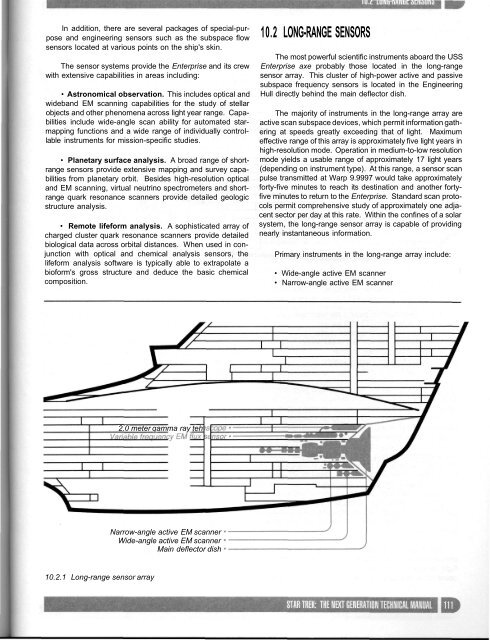franchise-star-trek-tng-technical-manual1
franchise-star-trek-tng-technical-manual1
franchise-star-trek-tng-technical-manual1
Create successful ePaper yourself
Turn your PDF publications into a flip-book with our unique Google optimized e-Paper software.
In addition, there are several packages of special-purposeand engineering sensors such as the subspace flowsensors located at various points on the ship's skin.The sensor systems provide the Enterprise and its crewwith extensive capabilities in areas including:• Astronomical observation. This includes optical andwideband EM scanning capabilities for the study of stellarobjects and other phenomena across light year range. Capabilitiesinclude wide-angle scan ability for automated <strong>star</strong>mappingfunctions and a wide range of individually controllableinstruments for mission-specific studies.• Planetary surface analysis. A broad range of shortrangesensors provide extensive mapping and survey capabilitiesfrom planetary orbit. Besides high-resolution opticaland EM scanning, virtual neutrino spectrometers and shortrangequark resonance scanners provide detailed geologicstructure analysis.• Remote lifeform analysis. A sophisticated array ofcharged cluster quark resonance scanners provide detailedbiological data across orbital distances. When used in conjunctionwith optical and chemical analysis sensors, thelifeform analysis software is typically able to extrapolate abioform's gross structure and deduce the basic chemicalcomposition.10.2 LONG-RANGE SENSORSThe most powerful scientific instruments aboard the USSEnterprise axe probably those located in the long-rangesensor array. This cluster of high-power active and passivesubspace frequency sensors is located in the EngineeringHull directly behind the main deflector dish.The majority of instruments in the long-range array areactive scan subspace devices, which permit information gatheringat speeds greatly exceeding that of light. Maximumeffective range of this array is approximately five light years inhigh-resolution mode. Operation in medium-to-low resolutionmode yields a usable range of approximately 17 light years(depending on instrument type). At this range, a sensor scanpulse transmitted at Warp 9.9997 would take approximatelyforty-five minutes to reach its destination and another fortyfiveminutes to return to the Enterprise. Standard scan protocolspermit comprehensive study of approximately one adjacentsector per day at this rate. Within the confines of a solarsystem, the long-range sensor array is capable of providingnearly instantaneous information.Primary instruments in the long-range array include:• Wide-angle active EM scanner• Narrow-angle active EM scanner2.0 meter qamma ray tehNarrow-angle active EM scannerWide-angle active EM scannerMain deflector dish10.2.1 Long-range sensor array


